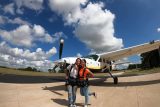Skydiving is one great lesson in physics. At any given time during your one-minute freefall or five-minute canopy ride, a number of forces are simultaneously at play impacting how you fly.
It’s important to have a basic understanding of these heading into your first skydive because educating yourself about what’s happening during your first flight at The Skydiving Company and why can help to improve your overall experience.
Freefall
Once you exit the plane attached to one of our professional instructors, two forces immediately descend upon you. The first is gravity, which pulls you back down toward the ground.
The second is air friction, which can include the air pressure that’s pushing up against your body as you can speed. The two are working against each other, with each growing more powerful as you gain speed. But eventually, the strength of the gravity force equals the strength of the air pressure and you will have reached terminal velocity. You won’t accelerate any faster. Most people fall at a rate of about 120 miles per hour once they hit terminal velocity.
The friction that you feel in the air (which may begin to feel like an industrial-sized fan is blowing wind up at your belly from below you) is how skydivers control their movements. Pressing down on that friction with one arm, for example, will cause you turn. Pushing your legs straight back down on the friction will cause you to move forward. If you want to fall faster, you would reduce your surface area (think bringing in your arms and legs and scrunching into a ball). If you wanted to fall at a slower rate, you’d widen your arms and legs and create as much surface area as possible as though you’re a parachute attempting the capture the wind.
Canopy
The physics of the canopy depend on the size and shape of the parachute. The important thing with parachutes, however, is that they have a large enough surface area that the fabric can capture enough air to slow down the speed of your body to a safe landing speed.
When the parachute first opens, your body may feel a jolt as it’s being dramatically slowed from terminal velocity. This is the result of a massive shift in air pressure. Suddenly, you have more air pressure slowing your descent than you do force of gravity pulling you down.
Most skydivers today use rectangular canopies that are more steerable than the round canopies of the past. They have two toggles that attach to brake lines, which provide the canopy pilot the ability to land on a target with precision.
Pulling down on toggles changes the shape of the canopy and impacts how air rolls through it. Dipping to one side versus another will cause the parachute to turn, while pulling down on both toggles simultaneously will cause the back to dip, catching more air, and braking the parachute.
Want to come check it all out for yourself? Contact us or book today!





